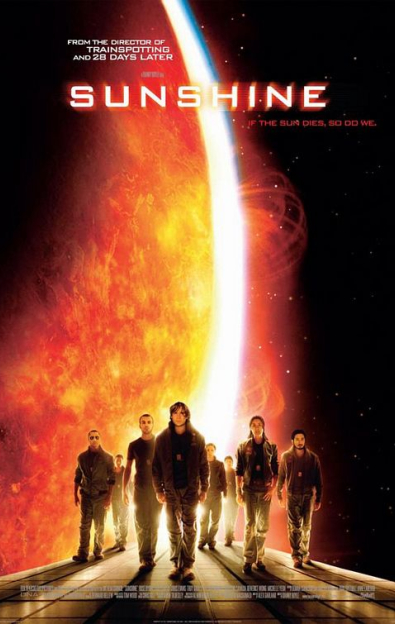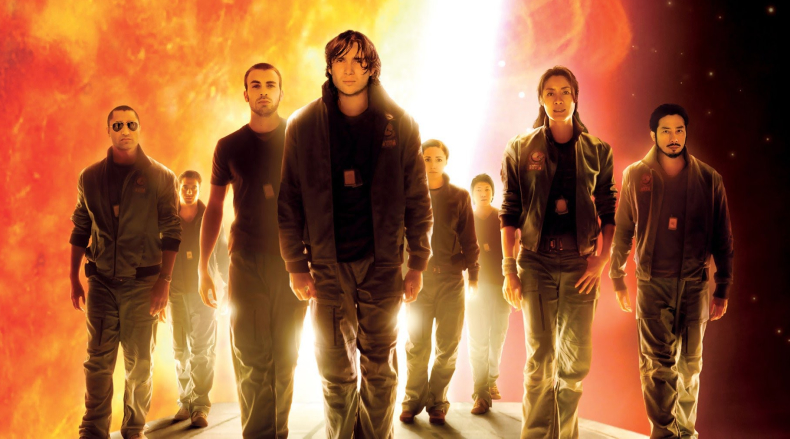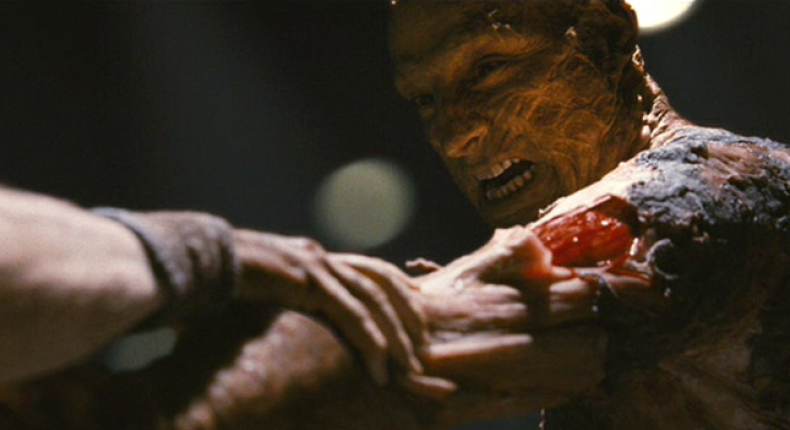Obvious Darkness & Hidden Light | Sunshine on its 10th Anniversary
We live because of the Sun. Ancient cultures worshipped it. Our solar system relies on its gravity. We use it to tell time. It is necessary for all life to exist, thrive and flourish. But the Sun can also kill us. It will kill us one day. Right now it burns us, gives us heatstroke, and causes cancer to develop. Thousands of years from now it will expand and flash fry our blue planet. For the moment it helps more than it harms and that is the focus of Sunshine.

Set in 2057, Sunshine sees a diverse crew of scientists and astronauts pilot an enormous stellar bomb in order to reignite Earth’s dying sun. Icarus II is not the first such mission. Icarus I was sent seven years ago but something went wrong and the sun continued to die. On its final approach around the planet Mercury, comms officer Harvey (Troy Garity) picks up a distress call from the Icarus I. Against the protests of Mace (Chris Evans) the rest of the crew decide that two payloads are better than one. Upon boarding Icarus I Sunshine goes from high concept sci-fi movie to essentially a slasher film in space.
The above description sounds at best thrilling and at worst cheap and dumb. It is thrilling but also maintains the intelligence and emotional resonance the film sets out with. Listening to Cillian Murphy as physicist Robert Capa explain the physics of nuclear fusion and the Sun itself is only interesting for so long. Director Danny Boyle and writer Alex Garland supplement the complicated metaphysics with deep psychological examinations of the characters. From the hopeful pilot Cassie (Rose Byrne) to the cynical biologist Corazon (Michelle Yeoh) right up to the Sun obsessed psych officer Searle (Cliff Curtis).
Searle is an interesting case not least because he is a psychologist bordering on sublime insanity. It is easy to see that the man has spent the entire journey obsessed with the Sun, its brightness, and its destructive power. Even before they discover Icarus I he is severely sunburned and keenly aware of his own mortality in the face of that enormous burning sphere of gas he so loves. When Captain Kaneda (Hiroyuki Sanada) and Capa step onto the bomb’s giant mirror to repair the reflective panels Icarus reverses their orbit putting both men in danger. But Kaneda is immolated by the ferocious heat of the Sun. As he stares at the wall of fire rolling towards him, Searle asks: “Kaneda… What do you see?” Kaneda does not answer him instead an unexpected answer comes from an unexpected place.
Captain Pinbacker (Mark Strong) of the original Icarus I boards Icarus II and in a fundamentalist frenzy attempts to sabotage the Icarus II. He kills both Cassie and Corazon and is indirectly responsible for the deaths of Mace, Harvey, and Searle. He and Searle are two sides of the same coin. Both are badly sunburned; Pinbacker disfiguringly so, both are obsessed with the lifegiving star and both cannot return to Earth after seeing the awesome majesty of the Sun. Pinbacker is only stopped when Capa detonates the stellar bomb inches from the surface of the Sun. But Sunshine’s complex characters and moving story would be just words on paper without the cinematic marvel Danny Boyle put to film a decade ago.
Sunshine is a film of light and dark. Characters are often lit in blue or orange. Thematically this is appropriate for a film that shows people losing and regaining their humanity. Each are reminded of what they are fighting for and each die fighting for it. Whether it’s Searle burning to death in the observation room of Icarus I or Mace freezing in the cooling fluid surrounding the flight computer every character goes down with teeth bared and fists clenched. Just as Pinbacker believes in sending humanity to heaven through a global freeze Capa believes in giving them a second chance by reigniting the Sun.

The Sun is perhaps the most impressive visual spectacle of the film. Its light turns a multi-kilometre hemisphere of mirrors into a golden dome. Sunspots expand and contract, solar flares twist and dance and solar winds howl like cosmic hurricanes. It is one of the most under-appreciated pieces of visual effects in cinematic history. The raw power, ferocity and glory of the Sun is only equalled by the film’s brave, if controversial, ending.
When I first volunteered to write this anniversary piece the Headstuff Film co-editor described the ending of Sunshine as “a tad ridiculous”. Now I won’t refute Peter’s claim here. He’s right, it might even be a bit more than a tad ridiculous but with that said I really can’t see Sunshine ending any other way. In hindsight the characters, if not the mission, are doomed from the start. Whether it’s the occasional sci-fi trope or subtler psychological tics it’s painfully obvious that none of these brave people will survive. And that’s okay because the ending is a gut-wrenching and emotionally draining masterpiece.
Pinbacker is never truly seen by the audience. The camera veers to the side or the view is distorted and out of focus. It cleverly mimics the effect of staring at the sun and cinematographer Alwin H. Küchler is due credit for this. Afterimages of the horrifically burnt man are seared onto our eyelids even though we never really saw him. Most horror films reveal the monster, in Sunshine we are left to imagine him.

But Pinbacker is not the crux of the successful ending instead it is Capa’s desperate and painfully slow march to the bomb. Encased in a gold, sun-proof spacesuit that looks like something out of a ‘50s utopian sci-fi story Robert Capa races through Icarus II and dives into space towards the bomb only just making it in time. All while John Murphy and Underworld’s score swells all around. Murphy’s score is truly something special but the climactic moments of the film; Kaneda’s death and Capa’s headlong rush to the bomb, are sound tracked by a song called Adagio in D Minor. This piece of music alongside Danny Boyle’s powerful imagery make the last ten minutes of Sunshine a masterpiece in audio-visual art.
Sunshine is a film about relationships. Our relationships with each other and how they can be built, destroyed, and rebuilt. It is also about our relationship with our star, how it gives us life and how it will one day destroy us. We remain at a perfect distance from it. Any closer and we will burn, any farther and we will freeze. A quote from Rose Byrne’s character Cassie perfectly sums up this horrifying yet necessary relationship:
“Only dream I ever have… is it the surface of the sun? Every time I shut my eyes… it’s always the same”

